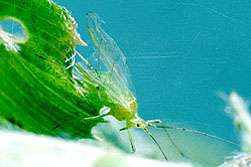Using a pest's chemical signals to control it

Agricultural Research Service (ARS) scientists are tapping into the biochemistry of one of the world's most damaging insect pests to develop a biocontrol agent that may keep the pest away from gardens and farms.
Aphids spread diseases that cost gardeners and farmers hundreds of millions of dollars each year. Some of the insecticides available are not environmentally friendly, and because aphids are developing insecticide resistance, some growers are being forced to use more of the chemicals.
Ronald J. Nachman, a chemist with the ARS Southern Plains Agricultural Research Center at College Station, Texas, is working with chemical signals known as neuropeptides that aphids and other organisms use to control and regulate a wide range of body functions, such as digestion, respiration, water intake and excretions. The effect triggered by the chemical signal is normally turned off when the neuropeptide is broken down by enzymes in the body. Nachman is developing neuropeptide mimics, or analogues, with slightly altered molecular structures that will not break down. His goal is to kill the pest by disrupting its digestion, water intake or some other biological function.
Nachman, along with Guy Smagghe of Ghent University in Belgium and other colleagues, mixed five candidate analogues into dietary solutions and fed each one to 20 caged pea aphid (Acyrthosiphon pisum) nymphs. The scientists found that one of the formulations killed 90 to 100 percent of the aphids within three days, at a rate and potency comparable to insecticides now on the market. The study was recently published in the journal Peptides.
Any biocontrol agent would have to be thoroughly tested before being released for commercial use. Nachman is continuing to test and evaluate the neuropeptide mimics. But he said the molecular structures of the class of neuropeptide he is studying, known as insect kinins, are so unique that such a biocontrol agent is unlikely to have any effect on humans, plants or other types of organisms.
Provided by United States Department of Agriculture















